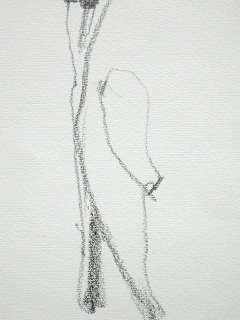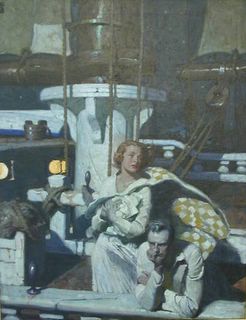skip to main
|
skip to sidebar
###
Drawings have always been a more intimate measure of an artist's greatness than paintings. In the words of Roberta Smith, "drawings are a direct extension of an artist's signature and very nervous system." Measure the drawings of illustrators and cartoonists by the same standards you would apply to the old masters, and I promise you some of them come out very well indeed. Here are samples of lovely drawings that were probably worth a closer look than ones you gave them while flipping through your newspaper or magazine: 
Fawcett

Bernie Fuchs

Fuchs detail

Noel Sickles

Arthur Szyk

Frank Frazetta
###
###
Great artists, writers and cultural leaders are often able to discern real quality in the popular arts. Some are not even afraid to talk about it:Vincent Van Gogh: Before he became a painter, Van Gogh aspired to be a magazine illustrator. He praised the quality of illustrations in magazines such as Graphic, Illustrated London News, L'Illustration, and Harper's Weekly, and clipped out their drawings, which he pasted in portfolios for further study. UCLA art professor Albert Boime quotes Van Gogh's correspondence on this topic: "[Van Gogh] declared: 'I would like to go to London with portfolio and visit the editors and managers of the illustrated journals-also get information about the different processes-a double-page spread allows for broader style.' That he fully intended to specialize in magazine illustration is seen in his hopeful observation that magazine editors would welcome 'somebody who considers making illustrations his specialty.'"Willem De Kooning: The darling of the abstract expressionist crowd came to America to find work as a commercial artist, abandoning Europe which was then the bastion of traditional gallery art. De Kooning said he was not concerned about the stigma of commercial art. He just knew that America was a place you could get ahead if you worked hard. He later turned from commercial art to house painting when he found that house painting paid more (at that time, $9 per day).
John Updike: a major fan of cartoon art, he collected comic strips from the newspapers, wrote fan letters to comic strip artists and collected their originals. He tried unsuccessfully to become a cartoonist, and later settled for being a writer. But to this day, he says "whatever crispness and animation my writing has, I credit the cartoonist manque." (Hogan's Alley No. 3, p.125)
Ad Reinhart: the famous abstract painter was a newspaper cartoonist in the 1940s and 1950s for the New York newspaper PM. (NYT December 21, 2003).
Michael Chabon, pulitzer prize winning novelist who now works in comic books, described the attraction as follows: "High art and low art, children's reading and adult's reading, the margins of trash and quality....comic books have always been border straddling, even, fundamentally, between words and pictures. There's something stimulating about hanging out at the borders there." (NYT March 17,2004)
Gilbert Seldes, one of the country's most prominent literary and art critic pronounced the comic strip Krazy Kat to be “the most amusing and fantastic and satisfactory work of art produced in America today.” The poet E.E. Cummings wrote an essay praising the art of Krazy Kat and describing the strip as a “living ideal” superior to “mere reality.” Other fans included the painters Joan Miro and Willem de Kooning as well as authors Jack Kerouac and Gertrude Stein.
###
###
 Once upon a time, artists found steady employment working for Popes and kings. From the cave paintings at Lascaux to the temple paintings at Karnak, from the Sistine Chapel to the palace at Versailles, the best artists could always feed their families creating artwork for the church or the state. Then, one by one, kings and pharoahs and Popes and Dukes stopped commissioning new art. Corporations emerged as the new centers of economic power. They also became the primary purchasers of art.
Once upon a time, artists found steady employment working for Popes and kings. From the cave paintings at Lascaux to the temple paintings at Karnak, from the Sistine Chapel to the palace at Versailles, the best artists could always feed their families creating artwork for the church or the state. Then, one by one, kings and pharoahs and Popes and Dukes stopped commissioning new art. Corporations emerged as the new centers of economic power. They also became the primary purchasers of art.
Artists were forced to adapt to the new economic realities. There were fewer jobs illustrating the bible and more jobs illustrating women's magazines. The same gifted artists who once might have been commissioned to record historic battles found work painting for corn flake companies and car manufacturers. Although the sponsors and the subject matter both changed, the quality of the artwork did not. Throughout the 20th century, talented artists created drawings, paintings and other objects of great beauty on behalf of their new corporate patrons.

People with uncertain taste had difficulty recognizing the true quality of this work. They became disoriented by its commercial origins. They looked for marble pillars and gold frames to help identify what was beautiful. But those with insight and judgment are rarely misled by the packaging.
Now the world has turned once again. The market for illustration has atrophied and many of the most creative artistic talents have migrated to movies, computer graphics and video games. But for over a century, many of the most talented artists in the world found a steady paycheck in illustration.

This blog is to celebrate the glorious talent of the artists who illustrated stories, advertisements and comics in the 20th century, to showcase their work retrieved from private collections and crumbling newsprint publications, and to welcome dialogue on their accomplishments. The only way to react to art is personally. In my very personal view, creative artists who are worth a close look include:
Austin Briggs
Frank Brangwyn
J.C. Coll
Dean Cornwell
Robert Fawcett
Frank Frazetta
Bernie Fuchs
Charles Dana Gibson
J.C. Leyendecker
Winsor McCay
Howard Pyle
Alex Raymond
Norman Rockwell
Leonard Starr
Saul Steinberg
N.C. Wyeth
Who is on your list of greats?
###














